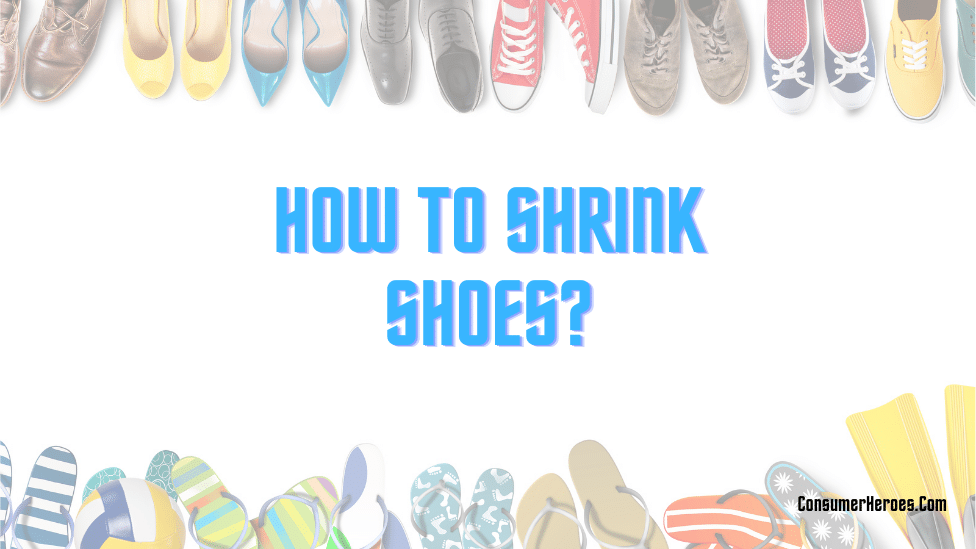Shoes are an essential part of our daily lives, and we all have that one pair that we love but can’t wear because they’re too big. Whether it’s a new pair of shoes that you bought online or an old pair that has stretched out over time, having shoes that don’t fit properly can be frustrating. Fortunately, there are various methods to shrink shoes that can help you achieve the perfect fit.
One of the most popular methods to shrink shoes is using heat. By applying heat to your shoes, you can shrink the material and make them smaller. This method is ideal for leather shoes, as they can withstand high temperatures without getting damaged. However, it’s important to note that this method may not work for all materials, and you should always check the care label of your shoes before attempting to shrink them.
Another method to shrink shoes is using water. This method involves soaking your shoes in water and then letting them dry. As the shoes dry, the material will shrink, resulting in a smaller size. This method is suitable for canvas and fabric shoes, but it may not work for leather or suede shoes. It’s also essential to ensure that your shoes are completely dry before wearing them again to prevent any damage.
Understanding Shoe Materials
Shoes are made from a variety of materials, and understanding these materials is crucial to properly shrink a pair of shoes. Here are some common materials used in shoe construction:
Leather
Leather is a popular material for shoes because it is durable, breathable, and can be stretched or shrunk. However, not all leathers are created equal. Some leathers, such as patent leather or corrected grain leather, have a protective coating that makes them resistant to stretching or shrinking.
Synthetic Materials
Synthetic materials like nylon, polyester, and vinyl are often used in athletic shoes because they are lightweight and breathable. However, these materials can be difficult to shrink because they are often designed to be water-resistant or waterproof.
Suede
Suede is a type of leather that has a napped finish, which means it has a soft, fuzzy texture. Suede can be difficult to shrink because it is delicate and can easily be damaged by water.
Canvas
Canvas is a durable, lightweight material that is often used in casual shoes and sneakers. Canvas can be shrunk by wetting it and then drying it in a hot dryer.
Rubber
Rubber is often used for the soles of shoes because it is durable and provides good traction. However, rubber cannot be shrunk because it is a synthetic material.
Understanding the materials used in your shoes is important because it will determine the best method for shrinking them. Always check the care label on your shoes to determine what materials they are made from and to ensure that you do not damage them during the shrinking process.
Methods to Shrink Shoes
There are several methods that can be used to shrink shoes, depending on the material of the shoes and the extent to which they need to be shrunk. Here are three effective methods:
Using Water and Heat
This method works well for shoes made of canvas or leather. First, dampen the shoes with water. Then, put them in the dryer on a high heat setting for about 20 minutes. Check the shoes periodically to make sure they are not getting too hot. When the shoes are dry, they should have shrunk to the desired size.
Using a Blow Dryer
This method is best for leather shoes. Start by putting on a pair of thick socks and then putting on the shoes that need to be shrunk. Use a blow dryer on the hottest setting to blow hot air onto the shoes, paying particular attention to the areas that need to be shrunk. Move the blow dryer around the shoes to ensure that they are heated evenly. Keep the shoes on until they cool down, which will help them retain their new shape.
Using Shoe Stretch Spray
This method is ideal for shoes made of suede or other delicate materials. Shoe stretch spray can be purchased at most shoe stores or online. Spray the inside of the shoes with the stretch spray and then put them on. Wear the shoes for a few hours until they dry completely. The spray will help the shoes conform to the shape of your feet and shrink slightly.
Remember that these methods may not work for all types of shoes, and it’s important to follow the instructions carefully to avoid damaging your shoes. With a little patience and care, however, you can shrink your shoes to the perfect size.
Factors to Consider
When it comes to shrinking shoes, there are several factors to consider. These include the shoe material, shoe size, and shoe style. Taking these factors into account can help ensure that the shrinking process is successful.
Shoe Material
The first factor to consider when shrinking shoes is the material they are made of. Different materials will react differently to the shrinking process. For example, leather shoes may require a different method than canvas shoes. It is important to research the best method for shrinking the specific material of the shoes in question.
Shoe Size
The size of the shoes is also an important factor to consider when attempting to shrink them. If the shoes are too large, they may not shrink enough to fit properly. On the other hand, if the shoes are too small, shrinking them too much could make them uncomfortable to wear. It is important to find a balance between shrinking the shoes enough to fit properly and not shrinking them too much.
Shoe Style
Finally, the style of the shoes should also be taken into account when attempting to shrink them. Certain styles, such as high heels or boots, may be more difficult to shrink than others. It is important to research the best method for shrinking the specific style of shoes in question.
Overall, taking these factors into account can help ensure that the shrinking process is successful and the shoes fit properly.
Common Mistakes to Avoid
When trying to shrink shoes, there are a few common mistakes that people often make. Avoiding these mistakes can help ensure that the shrinking process is successful and that the shoes fit comfortably.
Using Excessive Heat
One of the most common mistakes people make when trying to shrink shoes is using excessive heat. While heat is necessary to shrink shoes, too much heat can damage the shoes or cause them to shrink too much. It is important to follow the manufacturer’s instructions for the type of shoe you are trying to shrink and to use the appropriate amount of heat.
Not Testing the Shoes
Another mistake that people often make when trying to shrink shoes is not testing the shoes before wearing them. It is important to test the shoes to make sure that they fit comfortably before wearing them for an extended period of time. This can prevent discomfort or even injury caused by ill-fitting shoes.
Not Using the Right Materials
Using the wrong materials can also lead to shrinking shoes that are damaged or do not fit properly. It is important to use the right materials for the type of shoe you are trying to shrink. For example, using hot water instead of steam can cause certain types of shoes to warp or become damaged.
Rushing the Process
Finally, rushing the shrinking process can also lead to mistakes and damage to the shoes. It is important to take the time to follow the instructions carefully and to allow the shoes to shrink gradually. Rushing the process can cause the shoes to shrink too much or become damaged.
By avoiding these common mistakes, it is possible to successfully shrink shoes and ensure that they fit comfortably.
Maintenance Tips After Shrinking
After successfully shrinking your shoes, it’s important to take proper care of them to maintain their new size and shape. Here are some maintenance tips to follow:
1. Wear them with care
When you start wearing your newly shrunk shoes, be gentle with them. Don’t wear them for extended periods of time or engage in any strenuous activities. This will help prevent any unnecessary stretching or damage.
2. Store them properly
When you’re not wearing your shoes, store them properly to maintain their shape. Stuff them with tissue paper or shoe trees to help them keep their form. Avoid storing them in damp or humid areas, as this can cause them to stretch or warp.
3. Clean them regularly
Regular cleaning will help keep your shoes looking their best and prevent any damage. Use a soft brush or cloth to remove any dirt or debris, and avoid using harsh chemicals or abrasive materials.
4. Use a shoe stretcher
If you find that your shoes are still a bit tight after shrinking, consider using a shoe stretcher. This can help gently stretch the shoes to provide a more comfortable fit.
By following these maintenance tips, you can keep your newly shrunk shoes looking and feeling great for years to come.
Conclusion
In conclusion, shrinking shoes is a simple process that can be done at home with the right materials and methods. It is important to note that not all materials and shoes can be shrunk, and it is always best to check the manufacturer’s instructions before attempting to shrink any shoes.
When shrinking shoes, it is important to use hot water and heat to help the material shrink. However, it is also important to be careful not to damage the shoes or alter their shape too much. It is recommended to start with a small amount of shrinkage and gradually increase if necessary.
Using a shoe stretcher or wearing the shoes while they dry can also help to maintain their shape and prevent them from shrinking too much. It is important to remember that shrinking shoes is not a permanent solution and may need to be repeated over time.
Overall, shrinking shoes can be a useful technique to help improve the fit and comfort of shoes. With the right tools and techniques, anyone can shrink their shoes at home and enjoy a better fit.







